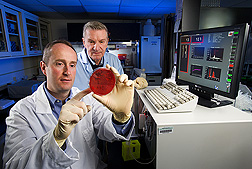New Mastitis Treatment May Offer Alternative to Antibiotics
A new weapon could be on tap for fighting bacteria that cause mastitis, an inflammatory udder disease of dairy cows costing around $2 billion annually in animal and milk-production losses.
In trials at ARS’s Bovine Functional Genomics Laboratory, Beltsville, Maryland, scientists Max Paape and Douglas Bannerman showed that injecting the cows’ mammary glands with the sugar Poly-x reduced mastitis infections at about one-twelfth the cost of antibiotics.
The sugar, a type known as a “polysaccharide,” occurs naturally in the cell walls of certain yeasts. But when administered to nonlactating (“dry”) dairy cows, the polysaccharide serves as a kind of biochemical bugle call that mobilizes the animals’ immune system, especially to produce bacteria-killing white blood cells.
“Previous work at Beltsville indicated that increasing the cell count in milk will prevent infection,” says Paape, a dairy scientist. “Poly-x increases the cell count in dry-cow secretions for the first 5 days of the dry period, thus preventing infection by bacteria.”
Today’s mastitis-control programs often use several measures, like diagnostic testing, sanitation, herd separation, animal culling, teat dips, and antibiotic treatment. For conventional dairy operations, antibiotics use can be expensive, costing about $10 a cow, or $45 million nationwide, Paape estimates. The practice is also controversial, with concerns focusing on the potential for environmental contamination and the emergence of antibiotic-resistant bacteria.
Paape and Bannerman see some advantages to using Poly-x as a natural alternative—the lack of residues being one. Another is the expense. A tube of antibiotic costs around $2.50. By comparison, the ingredient cost for an experimental Poly-x treatment is only 20 cents.
For their studies, the researchers injected 40 nonmilking Holstein cows with Poly-x and 40 with antibiotics. When the cows’ dry-off period ended, the researchers checked the animals for mastitis infections. “Cows injected with Poly-x had a net gain of 5 new infections at the beginning of the next lactation period, compared to 16 infections in cows receiving antibiotics,” says Paape. He and Bannerman will submit the work for scientific publication.
ARS has applied for patent protection on their yeast-sugar treatment and is seeking a licensing partner to commercially develop and market it to conventional and organic dairy farmers alike. While several companies consider Poly-x with this prospect in mind, ARS is negotiating terms to exclusively license another, earlier antimastitis technology from the Beltsville lab—namely, the recombinant protein CD14, which binds to and neutralizes endotoxins produced by bacteria that cause mastitis. (See “An Udder Solution for Bossie’s Woes,” Agricultural Research, June 2002, p. 18.)—By Jan Suszkiw, Agricultural Research Service Information Staff.
This research is part of Animal Health, an ARS National Program (#103) described on the World Wide Web at www.nps.ars.usda.gov.
Max J. Paape and Douglas Bannerman are with the USDA-ARS Bovine Functional Genomics Laboratory, Bldg. 1040, Rm. 208, Beltsville, MD 20705; phone (301) 504-8302, fax (301) 504-9498.
"New Mastitis Treatment May Offer Alternative to Antibiotics" was published in the February 2006 issue of Agricultural Research magazine.







